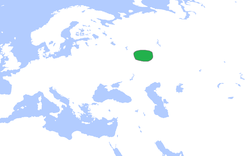Volga Bulgar
| Volga Bulgaria | ||||||||||||
| Itil Bulğar | ||||||||||||
|
||||||||||||
|
Volga Bulgaria (green), c. 1200.
|
||||||||||||
| Capital |
Bolghar Bilär |
|||||||||||
| Languages | Turkic (Bulgar, Sabir, Barsil, Bilar and Baranja) | |||||||||||
| Religion | Tengrism, later Islam (after Almish Iltäbär) | |||||||||||
| Government | Monarchy | |||||||||||
| Ruler | ||||||||||||
| • | 9th century | Kotrag | ||||||||||
| • | Early 10th century | Almish Yiltawar | ||||||||||
| • | Early 13th century | Ghabdula Chelbir | ||||||||||
| Historical era | Middle Ages | |||||||||||
| • | Established | 7th century | ||||||||||
| • | Conquered by the Mongols | 1240s | ||||||||||
|
||||||||||||
| Today part of |
|
|||||||||||
Volga Bulgaria (Tatar: Идел буе Болгар дәүләте İdel buye Bolğar däwläte, Chuvash: Атӑлҫи Пӑлхар Atălśi Pălhar) or Volga–Kama Bulghar was a historic Bulgar state that existed between the seventh and thirteenth centuries around the confluence of the Volga and Kama rivers, in what is now European Russia.
Information from first-hand sources on Volga Bulgaria is rather sparse. As no authentic Bulgar records have survived, most of our information comes from contemporary Arabic, Persian, Indian or Russian sources. Some information is provided by excavations. It is believed the territory of Volga Bulgaria was originally settled by Finno-Ugric peoples, including Mari people.
The Bulgars of Kubrat's son and appointed heir Batbayan Bezmer moved from the Azov region in about AD 660, commanded by the Kazarig Khagan Kotrag to whom he had surrendered. They reached Idel-Ural in the eighth century, where they became the dominant population at the end of the 9th century, uniting other tribes of different origin which lived in the area. Some Bulgar tribes, however, continued westward and eventually settled along the Danube River, in what is now known as Bulgaria proper, where they created a confederation with the Slavs, adopting a South Slavic language and the Eastern Orthodox faith.
...
Wikipedia

